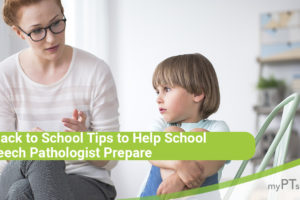Although I graduated from college with a secondary education degree, after student teaching for a semester, I knew I would never survive as a teacher. Working in a school helped me realize that I loved teaching, but not in large group settings. Since I also loved learning about anatomy, I applied to physical therapy school, and started a career where I could teach one on one instead of having to deal with whole classrooms full of students. However, many Physical and Occupational Therapists, as well as Speech Language Pathologists take their PT, OT, or SLP degree and head straight back to elementary school. Working as a school therapist presents many challenges that are unique to working in this setting. The one that comes to mind during this time of year is “Spring Fever!”
Spring Fever is so universal, Collin’s English Dictionary defines it as a common noun: “the feeling of restlessness experienced by many people at the onset of spring.” Yep, that’s it. How is a school therapist and the kids he or she works with supposed to stay focused on school work or therapy when the weather outside is calling them to come out and play? What most kids, teachers and school therapists need to conquer their spring fever is a vacation. Thankfully, all schools plan for a long break right about now. However, the reality is that anticipation of this break only intensifies our feelings of restlessness! The weeks right before spring vacation or right before school lets out for the summer are some of the most difficult times to stay focused.
The key to successfully conquering spring fever might be to tackle the focus issue head on. If you are speech, occupational or physical therapist who is courageously trying to help your students make progress in their goals, despite spring fever, the following are some great resources to help you, and your students, stay focused:
Teach Kids to Ignore, the Right Way
Jill Kuzma’s Social and Emotional Skill Sharing Site
The GOALS Program (Goal Orientation, Attribution Learning and Self Control) was first developed for Preschool Children, but can be used with any age.
Homework Secrets for Kids Who Just Can’t Buckle Down
from ADDitude Magazine: An online blog full of strategies and support for ADD and LH
Lesson 10: Ignoring Distractions
From Skillstreaming the Elementary School Child: Teaching Prosocial Skills (3rd ed.), © 2012 by E. McGinnis, Champaign, IL: Research Press (www.researchpress.com, 800-519-2707).
Snap, Crackle, Pop Classroom Exercise
From Ropes & Challenges Education Curriculum Guide
Participants stand in a circle and all face in, towards the center. The leader selects one member to begin after demonstration. Participants say: “SNAP” and make the appropriate arm motion either left or right (Snap: hold right arm overhead pointing left or hold left harm overhead pointing right). The person who is pointed to must say: “CRACKLE” and make the appropriate arm motion either left or right (crackle: hold right arm chest high pointing left or hold left arm chest high pointing right). The participant who was pointed to must say: “POP” and make the appropriate arm motion towards someone across the circle from them (Pop: clap both hands together, palms touching, fingers pointed away from your body and pointing to a particular person).
Participants may snap or crackle to their immediate left or right. The participant can Pop anywhere else in the circle, but not to their immediate left or right (except when there are less than five people in the circle). A player is “out” if they say the wrong word or do the wrong action, or don’t do anything when it’s their turn.
The group then put their thumbs in the circle and says: “you’re out of here” (as an umpire would throw a player out of a baseball game). The players who are now “out” must walk about the circle and call out to the active players, trying to distract them. No touching is allowed.
After playing a few rounds relate the game to the idea of ignoring distractions. Discuss the idea that the students had to stay very focused and use ignoring skills when someone was deliberately trying to get their attention. Discuss whether this happens in class and how/when students could use their new skills.




